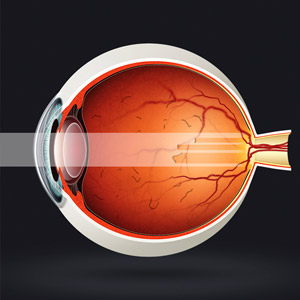These are usually small particles or protein strands in the jelly inside your eye. They are harmless, and are usually only an irritation. As they move around inside your eye, the strands cast shadows on the retina on the back of your eye, and these are then perceived as small particles or strands, or wispy threads. They always move, and appear to “jump” out of the way when you try to look at them. They are more obvious if you are looking at a light surface, like the blue sky, or a white piece of paper. As we get older (50 to 70 yrs), the jelly substance inside our eyes becomes more fluid like, and floater activity gradually increases.
Eye floaters can be clumpy or stringy; light or dark. They are caused by clumps or specks of undissolved vitreous gel material floating in the dissolved gel-like fluid (vitreous) inside the eye.
.
They might annoy you, but they shouldn’t interfere with your sight. You can learn to live with floaters and ignore them. You may notice them less as time passes. Only rarely do they get bad enough to require treatment.
Signs and Symptoms
Floaters earn their name by moving around in your eye. They tend to dart away when you try to focus on them.
They come in many different shapes:
- Black or gray dots
- Squiggly lines
- Threadlike strands, which can be knobby and almost see-through
- Cobwebs
- Rings
The shrinking vitreous can tug on the retina and pull away from it. This event, called a posterior vitreous detachment, or PVD is common, and usually doesn’t threaten vision. In about one in six people, a posterior vitreous detachment causes the retina to tear.
Fluid from inside the eye can then seep through the tear and separate the retina from the tissues that nourish it. This separation called retinal detachment, is an ocular emergency, and can lead to permanent vision loss.
Light flashes known as photopsias can occur when your retina receives non-visual (mechanical) stimulation, which can happen when it is being tugged, torn or detached. These light flashes may appear as lightning bolts, flickering lights or random sparks.
Key warning signs include:
- A sudden new onset of floaters and flashes of light, usually only in one eye.
- A shower of floaters and spots, especially if they are accompanied by flashes of light.
- Gradual shading of vision from one side (like a curtain being drawn).
- Rapid decline in sharp, central vision.
The sudden appearance of these symptoms could mean that the vitreous is pulling away from your retina, or it could mean that the retina itself is becoming dislodged from the back of the eye's inner lining, which contains blood, nutrients and oxygen vital to healthy function.
Noticing a few floaters from time to time is not a cause for concern. However, if you see any of the above signs, you should seek medical attention immediately from an eye care professional.
Sadly, retinal tears and detachments are completely painless, and people tend to ignore them till it is too late to recover much functional vision. Do not ignore these symptoms. Seek attention immediately.
Causes and Risks
Floaters occur when the vitreous, a gel-like substance that fills about 80 percent of the eye and helps it maintain a round shape, slowly shrinks.
As the vitreous shrinks, it becomes somewhat stringy, and the strands can cast tiny shadows on the retina. These are floaters.
In most cases, floaters are part of the natural aging process and simply an annoyance. They can be distracting at first, but eventually tend to “settle” at the bottom of the eye, becoming less bothersome. They usually settle below the line of sight and do not go away completely.
Stats and Incidence
A recent study published in Ophthalmology, showed that, among people who experienced the sudden symptom of eye floaters and/or flashes of light, 39.7 percent had a posterior vitreous detachment and 8.9 percent had a torn retina.
Other research has shown that up to 50 percent of people with a retinal tear will subsequently develop a detachment of the retina.

Obstruction of light focusing on retina resulting in shadows
When we are born and throughout our youth, the vitreous has a gel-like consistency. But as we age, the vitreous begins to dissolve and liquefy to create a watery center.
Some undissolved gel particles occasionally will float around in the more liquid center of the vitreous. These particles can take on many shapes and sizes to become what we refer to as "eye floaters." Floaters are more likely to develop as we age.
You are more likely to get floaters if you:
- Are nearsighted (you need glasses to see far away).
- Have diabetes.
- Have had surgery for cataracts.
- Have had inflammation (swelling) inside the eye.
Treatment
For people who have floaters that are simply annoying, no treatment is recommended.
On rare occasions, floaters can be so dense and numerous that they significantly affect vision. In these cases, a vitrectomy which is a surgical procedure that removes floaters from the vitreous, may be needed. This procedure removes the vitreous gel, along with its floating debris, from the eye. The vitreous is replaced with a salt solution. Because the vitreous is mostly water, you will not notice any change between the salt solution and the original vitreous.
This procedure does however carry significant risks to sight because of possible complications.
Complications can include:
- Retinal detachment.
- Bleeding.
- Retinal tears.
- Cataracts.
Most eye surgeons are reluctant to recommend this surgery unless the floaters seriously interfere with vision.
If a tear is detected early, treatment can prevent the retina from detaching. Tears can be treated several ways. Pinpoints of laser light can be used to fuse the retina to the back wall of the eye. Extreme cold, a procedure called cryopexy, does much the same thing.
Cold and laser light can also be paired with the injection of a gas bubble into the eye (pneumatic retinopexy) to repair a detached retina. Two operations, scleral buckling and vitrectomy, can also be used to reattach the retina.


